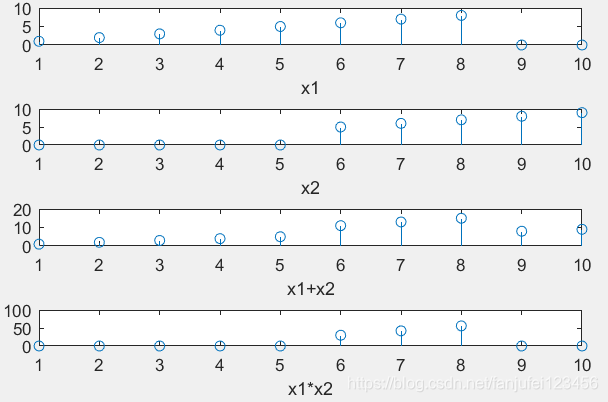目录
1、信号相加与相乘
用数学描述为:
 ,
, 。然对于给定的序列不一定一样长,可以用补零法使得对应位相同,再进行运算,如下:
。然对于给定的序列不一定一样长,可以用补零法使得对应位相同,再进行运算,如下:
例1:当
 =[1 2 3 4 5 6 7 8],取值范围为n=1:8,对于
=[1 2 3 4 5 6 7 8],取值范围为n=1:8,对于 =[5 6 7 8 9],取值范围为n=6:10。求相乘与相加的值。
=[5 6 7 8 9],取值范围为n=6:10。求相乘与相加的值。
clear
clc
n1=1:8;
x1=[1 2 3 4 5 6 7 8];
n2=6:10;
x2=[5,6,7,8,9];
n=1:10;
x11=[x1 zeros(1,10-length(n1))];
x22=[zeros(1,10-length(n2)),x2];
x33=x11+x22;x44=x11.*x22;
subplot(411),stem(n,x11);xlabel('x1');
subplot(412),stem(n,x22);xlabel('x2');
subplot(413),stem(n,x33);xlabel('x1+x2');
subplot(414),stem(n,x44);xlabel('x1*x2');

2、序列移位与周期延拓
序列移位:

周期延拓:
 ,M为延拓周期。
,M为延拓周期。
clear
clc
N=24;M=8;m=3;
n=0:N-1;
x2=[(n>=0)&(n<M)];
x1=0.5.*n;
x=x1.*x2;
xm=zeros(1,N);
for k=m+1:m+M
xm(k)=x(k-m);
end
xc=x(mod(n,M)+1);
subplot(311),stem(n,x);
subplot(312),stem(n,xm);
subplot(313),stem(n,xc);

3、序列翻转与序列累加
序列翻转:
 ,由函数y=fliplr(x),左右翻转。
,由函数y=fliplr(x),左右翻转。
序列累加:
 ,由函数y=cumsum(x),来实现。
,由函数y=cumsum(x),来实现。
x=[1 2 3 4 5];
x1=fliplr(x)
x2=cumsum(x)
x1 =
5 4 3 2 1
x2 =
1 3 6 10 15
4、两序列卷积运算
卷积运算:

实现函数:y=conv(x1,x2),序列必须长度有限。对于这个函数的实现还可以自定义出解法。
x=[1 2 3 4 5];
x1=[1 1 1 1];
y=conv(x,x1)
y =
1 3 6 10 14 12 9 5
来源:CSDN
作者:范飓飞
链接:https://blog.csdn.net/fanjufei123456/article/details/104463357